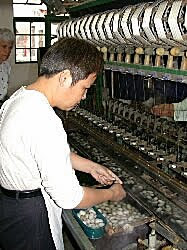
At the Beijing silk "factory".
| Silkworm larvae of about 3mm are hatched from eggs. For about 20 to 30 days, they are fed five times a day on chopped mulberry leaves. Now they are ready to spin cocoon for which racks, clusters of twigs or straw are provided. The caterpillars have small openings under their jaws called spinnerets through which they secret a protein like substance. This substance solidifies when it comes in contact with air and the filament thus formed is spun around the silkworm in the figure resembling the digit 8. In three days the cocoon gets completed which is about a peanut shell's  size. The silkworm creates its cocoon out of a single silk thread that is continuous for approximately 3,600 feet. The filament is held together by sericin or silk gum. The life of the worm is ended by the process of 'stoving' in which the cocoons are heated.  The cocoons are then soaked in water to allow the workers to easily locate the end of the silk thread, which is necessary to unravel the silk thread from the cocoon. The soaked cocoons, when ready, are then placed into a water tray in preparation for unraveling. A single thread is too thin to be of use and, therefore, multiple threads must be joined and unraveled to form a single thread. The worker locates the ends of about eight cocoons, and combines them onto the spinning machine. The spinning machine then automatically unravels the eight cocoons simultaneously creating a single strand of silk from the eight cocoons. Pulling raw silk to make quilts.   |
No comments:
Post a Comment